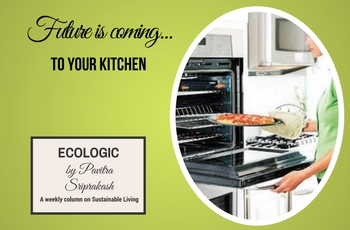08 Jul 2017, New Indian Express: ECOLOGIC- Pavitra Sriprakash, the Chief Designer and Director of Shilpa Architects writes about what can makes a kitchen smart and sustainable.
Read More: PDF | Link to New Indian Express Site
Full Text below:
Future is coming… to your kitchenBuilding a dream kitchen can be a fairly involved affair given the bewildering choices of constantly changing technologies and gadgets. Smartphones nowadays operate microwave ovens remotely; refrigerators even “talk” to the grocer for automatic refills! And I say, “wow! it’s alright”! But, if a kitchen were to be deconstructed, it will just be — cabinets, accessories and fittings. Tweaking them makes you cook more efficiently. So, what makes a kitchen smart and sustainable? Incorporating anthropometric standards in a well lit and ventilated kitchen that functions easily is of course a great brief to start. Kitchens as per NBC 2016, must be at least 5 sqM with a minimum height of 2.75 m and not less than 1.8m width; and provided with means for the washing of kitchen utensils that lead directly or through a sink to a grated and trapped connection to the waste pipe. They must have an impermeable floor; a flue, and a window or ventilator between 0.3 to 0.45 sqM depending on the climatic zone. Bespoke kitchens address preferences for say, drawers rather than cupboards for efficient space utilisation, specialist storage units to suit specific requirements; or simply accessing hard to reach spaces with first quality SS hardware. Plywood or wood composites like MDF or HDF used in cabinetry have varying proportions of recycled materials in them. Unless properly manufactured, formaldehyde used as adhesives in plywoods and paints will off-gas through its life cycle, directly affecting the indoor air quality. The Australian Government’s Water Efficiency Labelling and Standards (WELS) (www.waterrating.gov.au/consumers), promotes water conservation. If water was priced correctly and we had standards too, then Indians would also be sensitive about wasting water. Efficient dish washing machines and low flow fixtures with aerators cut water consumption substantially. So do shallow sink bowls which consume 30% less water; but require careful use to prevent water spillage. BEE (Bureau of Energy Efficiency, www.beestarlabel.com), is an initiative of the Union Ministry of Power, Government of India, that provides information about an appliance’s energy consumption. It regulates the information on these energy rating labels and standardises energy consumption levels. BEE insists that the energy label must have the device’s kWh (KiloWatt Hour) usage per annum printed on them. This figure is usually available at the centre of the BEE energy label. There are energy efficient lighting choices in the kitchen too, with LEDs being competitive in price and efficiencies as compared to the CFLs. Kitchen design and execution can be completed with local and regional materials to keep a check on the overall carbon impact. The embodied energy of any product to the consumer includes the energy consumed in the manufacture till it reaches the market and finally to the individual. Sadly, neither is such data available readily nor is it comprehensive. The future is coming at us faster and faster. New smart devices and materials are constantly innovated for the kitchen is a ripe place for household technological development. However complicated it may seem, never forget to add in some humble containers for compost, recycling and waste! Sustainability is about inclusive efficiencies of many components. Enjoy a Green Kitchen — you deserve it! |



